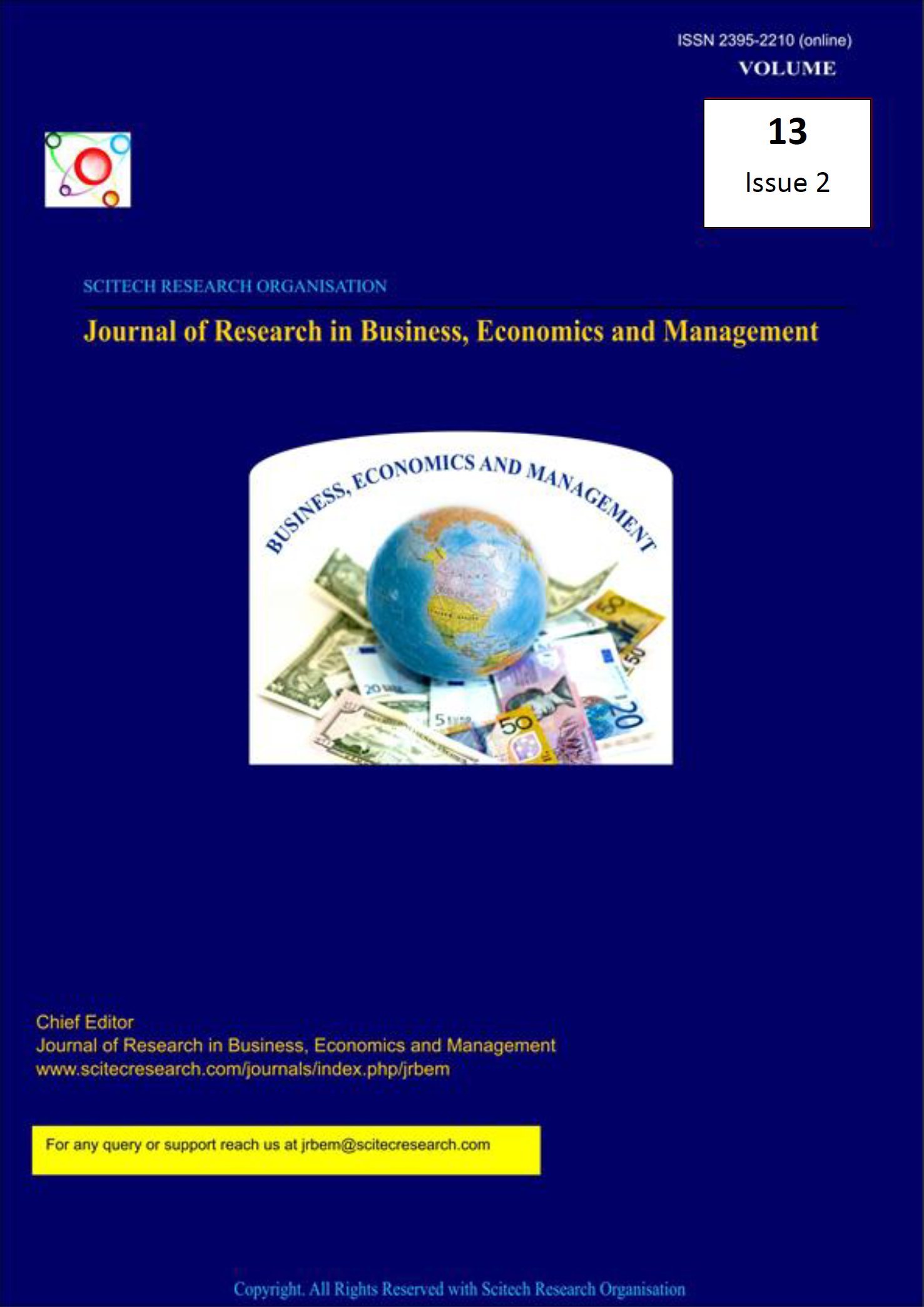The influence of Equity and Trade credit Finance structure on SME’s Growth in Rwanda
Abstract
The study investigated the influence of equity and trade credit finance structures on the growth of manufacturing SMEs in Rwanda. Two objectives guided the study; to determine the influence of equity finance structure on the growth of manufacturing SMEs in Rwanda and to investigate the influence of trade credit finance structure on the growth of manufacturing SMEs in Rwanda. The study used a mixed research design approach for collecting and analyzing data using a target population of 868 SMEs registered with Rwanda Development Board as of November 2017. Stratified random sampling technique was utilized to draw a sample size of 273 SMEs. Close-ended questionnaires were employed in data collection and data was analyzed using Statistical Package for Social Science (SPSS) to generate descriptive statistics including percentages, frequency tables and mean scores. Multiple regression analysis was used to explore the relationship between trade credit, debt finance and growth of small and medium size manufacturing enterprises in Rwanda. Analysis of variance (ANOVA) was utilized to test the significance of the model. R2 indicted the extent of the goodness fit of the regression model. The study findings showed that equity finance had a positive and significant influence on growth of small and medium manufacturing enterprise in Rwanda. Trade credit finance was also found to have a positive and significant influence on growth of small and medium manufacturing enterprise in Rwanda. The study recommends that the management of SMEs should be trained on the use of accounts receivable and accounts payable to fully take advantage of trade credit finance structure. This will ensure the SMEs grow their operations even during time of low liquidity
Downloads
References
[2] Amy, F. and Lien, B. (2013) The Use of Trade Credit by Businesses. Bulletin,Reserve Bank of Australia
[3] Barclay, M. J., & Smith, C. W. (2005). The capital structure puzzle: The evidence revisited
[4] Bell, K. & Vos, E. (2009) SME Capital Structure: The Dominance of Demand Factors 22nd Australasian Finance and Banking Conference 2009. University of Waikato – Department of Economics and Finance
[5] Boissay.F and Gropp. R (2007) , Trade credit defaults and liquidity provision by _rms. European Central Bank working paper series 753
[6] Carbo, V.S., Fernandez, R.F. and Udell, G.F (2012) Trade credit, the financial crisis and firm access to finance. Accessed online at: www.ugr.es/~scarbo/TradeCredit2012.pdf on 10th/10/2018
[7] Carvalho C. J., & Schiozer, R.F. (2014) Determinants of Supply and Demand for Trade Credit by Micro, Small and Medium-Sized Enterprises. FederalUniversity of Uberlândia
[8] Covas, Francisco, and Wouter J. Den Haan. 2012. ìThe Role of Debt and Equity Finance over the Business Cycle.îEconomic Journal 122 (December): 1,2
[9] Cuñat, V. (2007), “Trade credit: Suppliers as debt collectors and insurance providers,” Review of Financial Studies 20(2) pp. 491-527
[10] Dermirguc-Kunt and Maksimovic (2001) argue that trade credit is the important alternative to bank loans as a source of external funding in the SME sector in developed and developing economy alike
[11] Elahia, M. & Dehdashti, M. (2011) Classification of Researches and Evolving a Consolidating Typology of Management Annual Conference on Innovations in Business & Management London, UK,
[12] Fosnacht, K (2012, March) Undergraduates coping with financial stress; A latent class analysis . Paper presented at the annual meeting of the American College Personel Associaiton, Las Vegas, NV.
[13] Garcia-Appendini, E., Montoriol-Garriga, J., 2013, Firms as liquidity providers: Evidence from the 2007-2008 financial crisis, Journal of Financial Economics, 109, 272-291.
[14] Guillaume, A., Stagliano, R. and Van der Zwan, P. (2015) Bank Debt and Trade Credit for SMEs: International Evidence. Erasmus University Rotterdam (EUR) - Erasmus School of Economics (ESE).
[15] Mateut, S., Bougheas, S. & Mizen, P. (2006) Trade credit, bank lending and monetary policy transmission European Economic Review 50 PP 603–629
[16] Nanyondo, M. (2017) Access to debt finance and its determinants in Uganda: An empirical investigation of Small and Medium-sized Enterprises (SMEs) PhD Thesis Bournemouth University
[17] Ndikubwimana P. . (2016). The role of financial institutions in promoting innovation of SMEs in Rwanda; An empirical review:. British journal of Economics, Management and Trade 14(2): 2016, article n0. BJEMT.26746 ISSN: 2278-098X , 1-14.
[18] Njagi. K. I., Maina, K. E., Kariuki, S. (2017) Equity financing and financial performance of small and medium enterprises in Embu own, Kenya International Academic Journal of Economics and Finance | 2 (3) pp. 74-91
[19] Rodríguez, O. M (2006) Trade credit in small and medium size firms: an application of the system estimator with panel data. Journal of Small Business Economics 27 (2-3) PP 103 – 126
[20] Stiglitz, J., and A. Weiss. (1981). Credit Rationing in Markets with Imperfect Information to action for psychology. . American Psychologist, 62(6), 575. to Stability and Prosperity in South Eastern Europe
[21] Wilner, Benjamin S., (2000), The Exploitation of Relationships in Financial Distress: The Case of Trade Credit, Journal of Finance 55 (February), 153−78.
[22] Zikmund, G.W., Babin, B.J., Carr, C.J., & Griffin, M . (2010). Business Research Methods 8th ed. South-Western, CengageLearning. .
TRANSFER OF COPYRIGHT
JRBEM is pleased to undertake the publication of your contribution to Journal of Research in Business Economics and Management.
The copyright to this article is transferred to JRBEM(including without limitation, the right to publish the work in whole or in part in any and all forms of media, now or hereafter known) effective if and when the article is accepted for publication thus granting JRBEM all rights for the work so that both parties may be protected from the consequences of unauthorized use.





